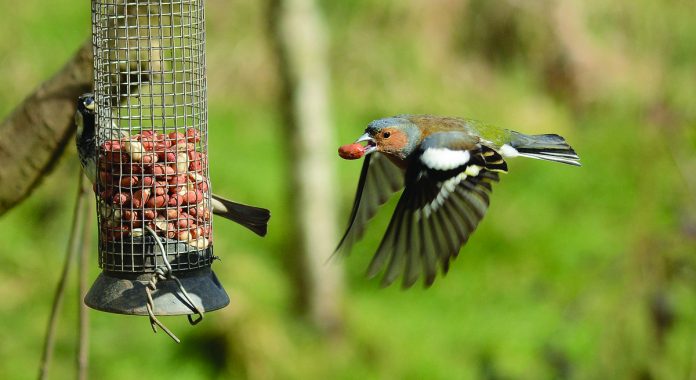If fall temperatures arrive this weekend as predicted, it will feel like it’s time to fill the backyard bird feeders. Colder morning temperatures send hungry birds to well-stocked feeders. Here are some tips to help make any backyard feeding station a success.
Sunflower seeds
Whether you’re new to feeding birds or just want to keep it simple, nothing beats black-oil sunflower seed in quality tube feeders. Droll Yankees and Aspects make the best tubes on the market, and they last for decades. Cheaper tubes sold in big box stores often crack or break before winter is over.
Black-oil sunflower seed is the single food that attracts the greatest variety of seed-eating birds. Its thin shell is easy to crack, and the kernel has a high oil (energy) content. In fact, black-oil sunflowers are grown primarily as a source of sunflower oil sold in grocery stores.
Striped sunflower seeds also attract many seed-eating birds, but its heavier shell is more difficult to crack for smaller birds. It’s a favorite of cardinals, grosbeaks and blue jays. Offer striped sunflower seeds in tubes, on platform feeders or in hopper feeders. I prefer these feeders made from 100% recycled plastic materials that simulate wood, resist absorbing oils from seeds and weather well.
Hulled seeds
When buying sunflower seeds, keep this in mind. Birds do not eat the shells. The shells of sunflower seeds simply accumulate on the ground. In fact, as much as 45% of the weight of every bag of sunflower seed goes to waste.
Hulled sunflower seeds are more expensive because extra work is required to mechanically remove the seed shells. Every kernel is eaten. There is no mess and no waste. Despite the higher cost, sunflower kernels are the best value in bird food, but because the seeds’ protective shells have been removed, they must be kept dry.
Other seeds
Nyjer, the tiny black seeds often incorrectly called “thistle,” attracts goldfinches, house finches, pine siskins and purple finches. Because Nyjer is imported from Africa and southeast Asia, it’s more expensive than sunflower seed, but its high oil content makes it great winter food. Offer Nyjer in a tube feeder specifically designed with tiny feeding ports for finches.
Nuts are another more expensive bird food, but their appeal to species such as chickadees, titmice, nuthatches and woodpeckers justifies the expense. Peanuts, walnuts and pecans are the more familiar nuts that are commonly found in higher-quality nut mixes.
Like hulled sunflower kernels, nuts must be protected from rain and snow. Try Droll Yankee’s “Big Top,” a bowl-style feeder protected from above by a large dome. It lacks perches, so only strong-footed, clinging birds can access the feeding ports.
White millet is a favorite seed for ground feeders such as song sparrows, white-throated sparrows, towhees, doves and juncos. Don’t put millet in elevated tube or bowl-style feeders. Birds that use these feeders, such as woodpeckers and chickadees, rarely eat millet.
Instead, scatter millet on platform feeders or even on the ground. Remember that millet is the primary ingredient in many bird seed mixes. Also, read the ingredients labels found on seed mixes.
Don’t buy mixes that include milo (sorghum) or cereal grains such as wheat and oats. These are filler seeds that birds rarely eat. They simply increase the profit margin for seed packagers.
Finally, suet is a favorite of woodpeckers, chickadees and nuthatches. Best offered in inexpensive, plastic-coated wire baskets, suet is high-energy animal fat. It’s available commercially in blocks, or you can easily make your own. See last week’s column for my favorite suet recipe.
Dragonfly follow-up
My recent column about dragonfly swarms attracted a lot of interest and subsequent email. I heard from readers in West Virginia, Ohio, Pennsylvania, New York, Tennessee and Florida. Virginia, however, gets the prize for most responses.
Every writer described seeing “dozens,” “hundreds” or “thousands” of dragonflies and all appeared to be feeding on a hatch of smaller flying insects. Some even sent me videos they had taken of the dragonfly swarms. Thanks to all who took time to reply.













